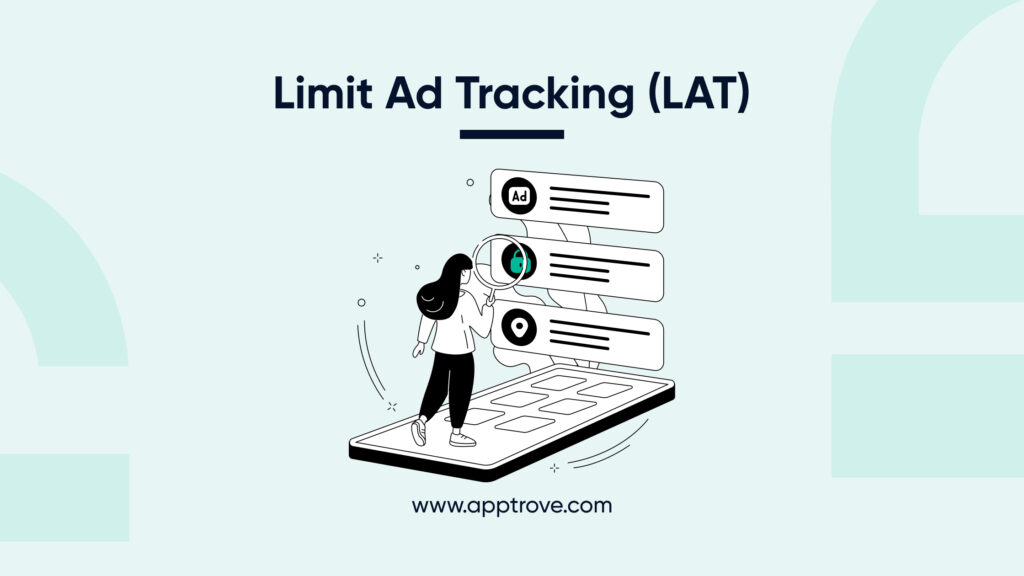For app owners and marketers, understanding Limit Ad Tracking (LAT) is important in both aspects of user privacy and business success. LAT was introduced first with iOS 10 in the year 2016 and it greatly transformed the ways through which advertisers could communicate with their users through advertisement.

What is Limit Ad Tracking?
Limit Ad Tracking is a technique through which users can opt-out for their personal data like device ID being exposed on the internet and LAT enhances the privacy and security of users. When LAT is enabled, it replaces the device’s identifier (IDFA) with zeros thereby making the device anonymous for advertising.
This privacy-focused feature, first introduced by Apple and later adopted by other platforms, represents a significant shift in the digital advertising ecosystem. Beyond simply zeroing out identifiers, LAT signals to all advertisers and data brokers that the user explicitly does not wish to be tracked across apps and websites. The implementation varies slightly between operating systems, with Android referring to similar functionality as “Opt out of Ads Personalization.”
Impact of Limit Ad Tracking
The concept of the mobile advertising ecosystem has changed dramatically since the launch of Limit Ad Tracking. Where once there was simply an opportunity to opt out of tracking, there is now a highly developed privacy regime. LAT was the sole privacy control available to iOS users at the beginning of the pandemic, but ATT in iOS 14 played an entirely different game altogether. Now, apps must request explicit permission through an ATT prompt before accessing any user’s IDFA.
When users enable LAT, they gain greater control over their digital footprint while still receiving advertisements. However, these ads become contextual rather than personalized, meaning they’re based on the content being viewed rather than the user’s profile or behavior. This trade-off between personalization and privacy highlights the growing tension between advertising business models and user data protection.
For developers and marketers, limit ad tracking presents challenges in measuring campaign effectiveness and user engagement. Attribution becomes more difficult without persistent identifiers, forcing the industry to develop privacy-preserving measurement solutions. Meanwhile, regulatory frameworks like GDPR in Europe and CCPA in California have further strengthened these opt-out mechanisms, making them more prominent and accessible to users.
As privacy concerns continue to grow among consumers, technologies like LAT are increasingly becoming the standard rather than the exception. This evolution represents a fundamental rebalancing of power in the digital economy, where user consent and transparency are no longer optional but essential components of the advertising technology landscape.
How Limit Ad Tracking Affects Your App Revenue
As app professionals, you need to understand how LAT affects your operations:
Privacy Compliance: LAT assists in making your app GDPR and CCPA compliant so your users and your business do not suffer from compliance related problems.
User Trust: LAT policies can improve your relationship with users who respect their privacy and accepting LAT has the potential to lead to improved overall site performance due to increased user satisfaction and retention.
Revenue Considerations: Although it may adjust traditional ad targeting, Limit Ad Tracking stimulates new approaches to monetization like contextual advertising and improved user experience.
Implementing Limited Ad Tracking in Your App
Implementing LAT support requires attention to detail. When LAT is enabled, your app should:
- Properly handle zeroed IDFAs.
- Make changes and adapt to tracking measures appropriately.
- Maintain accurate analytics while respecting privacy choices.
Marketing Strategies in a LAT Environment
The presence of LAT requires adaptable marketing approaches. Consider focusing on:
- Creating compelling contextual advertising that doesn’t rely on personal data.
- Creating value propositions that resonate regardless of tracking.
- Establishing trust via clear privacy practices.
Limit Ad Tracking: Future Trends
The mobile advertising environment keeps evoloving with a focus on privacy. Apple’s ATT framework as well as similar measures that show that the user’s privacy will remain more valuable than ever. For the long run, app specialists and professionals, staying ahead of these trends while maintaining effective advertising strategies is very important.
Best Practices for Your App
Beyond Limit Ad Tracking, consider these practical approachedto further enhance user privacy:
- Clearly communicate your privacy practices.
- Regularly audit your tracking mechanisms.
- Develop alternative engagement strategies.
- Focus on delivering value independent of tracking capabilities.
Bottom Line
Limit Ad Tracking is a very important feature for users who value their privacy. For app owners and marketers, LAT represents both a challenge and an opportunity. By restricting the collection of personal data for advertising purposes, it provides better protection and control over what information is shared and how it is used. While it doesn’t eliminate ad tracking completely, it significantly reduces the exposure of personal data, offering users peace of mind in an increasingly connected world.
By understanding Limited Ad Tracking and using it correctly, one can become a step closer to protecting their privacy on the internet.